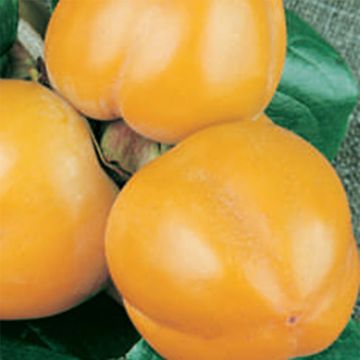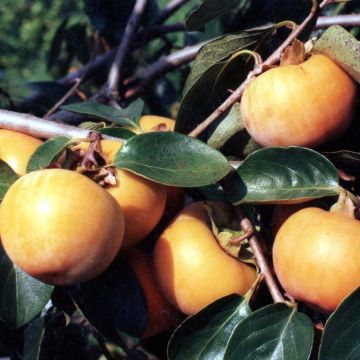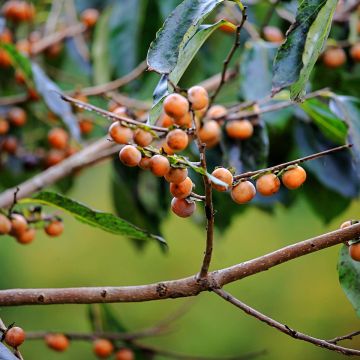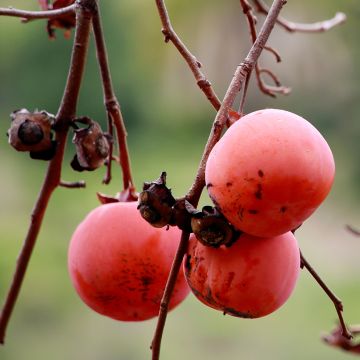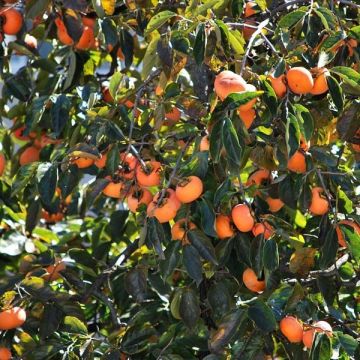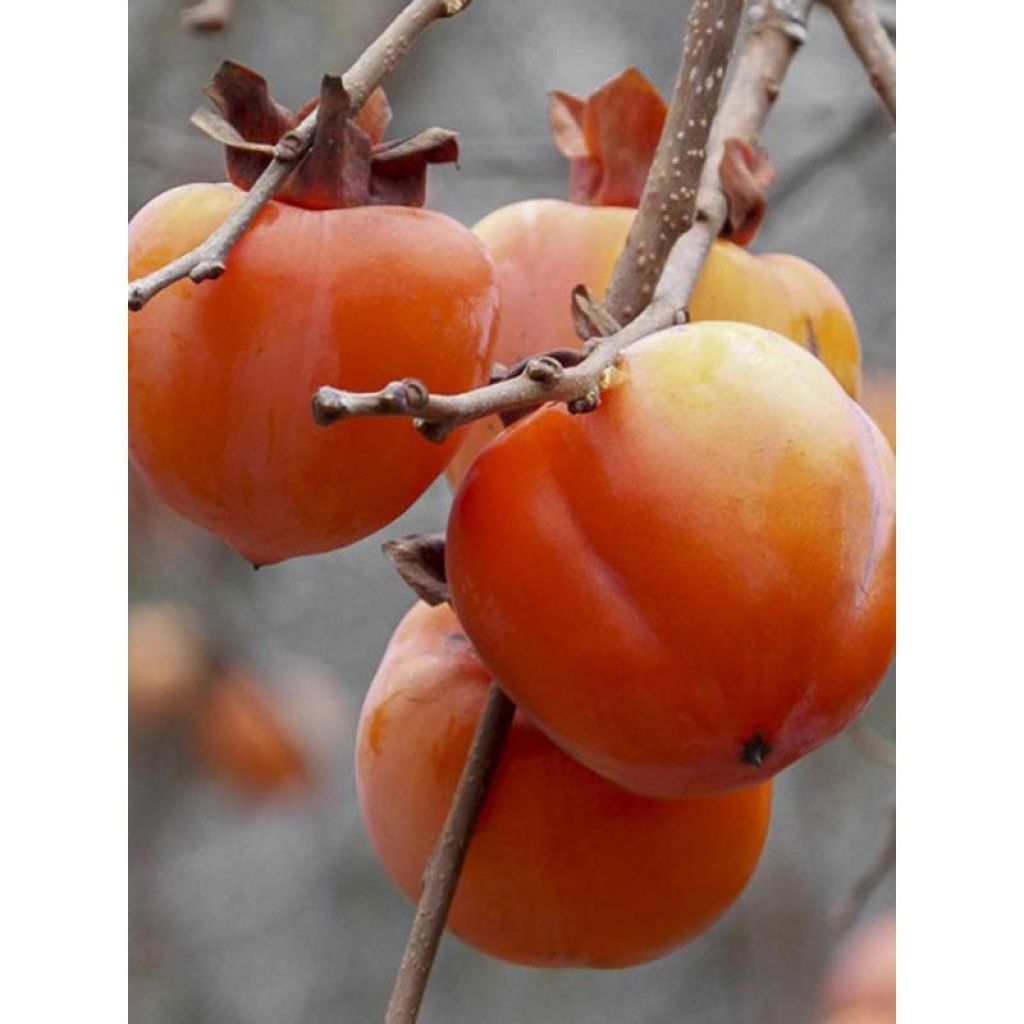

Diospyros kaki Rojo Brillante - Persimmon
Diospyros kaki Rojo Brillante - Persimmon
Diospyros kaki Rojo Brillante
Persimmon, Kaki, Japanese Persimmon, Oriental Persimmon
Received a very beautiful tree this morning, well wrapped, planted it immediately. A big thank you also for your availability, kindness, and the good advice you take the time to give to your customers. I highly recommend this very reputable company. See you soon for another order!
Doris, 07/11/2024
Why not try an alternative variety in stock?
View all →This plant carries a 6 months recovery warranty
More information
We guarantee the quality of our plants for a full growing cycle, and will replace at our expense any plant that fails to recover under normal climatic and planting conditions.
Oversize package: home delivery by special carrier from €6.90 per order..
Express home delivery from €8.90.
Delivery to Corse prohibited: UE law prohibits the import of this plant from mainland France to Corse as part of the fight against Xylella fastidiosa. Please accept our sincere apologies.
More information
Description
Diospyros kaki 'Rouge Brillant', also known as 'Rojo Brillante', is a large persimmon tree with particularly abundant and regular productivity. It is well-known to the general public through its large and delicious fruits found on stands in autumn and winter, sold under the name Persimmon. Its large, elongated, slightly ribbed fruit changes from yellow to dark red. When over-ripe, it contains a liquid, sweet, and slightly vanilla-flavoured pulp of excellent taste quality. It can be dried, sliced, and stored very well in a cool place. Late harvesting and ripening in December. This variety is to be reserved for the southern half of France or other hot regions.
The Kaki 'Rouge Brillant' is classified in the category of astringent persimmon trees, which means they can only be consumed when over-ripe, when they have a soft to mushy texture. To achieve this, they must have experienced the first frost. This variety produces very large fruits, averaging 270 grams, with a conical elongated shape and slightly ribbed, with moderately thin skin. They can be harvested and enjoyed when their colour is a reddish-orange, but are preferably consumed at physiological ripeness, when they have turned red. The pulp is then reddish-orange in colour, with a liquid texture, very little fibrous, and seedless. It is of very good taste quality and very sweet when fully over-ripe. The fruits can be cooked into marmalade or compote, eaten raw in salad with or without cream, or dried in the same way as figs. Explore all the different ways to discover their various flavors.
The Kaki (Dyospiros kaki) is a tree native to China, with a rounded habit, reaching 6 to 10 metres (20 to 33 feet) in height and 5 to 7 metres (16 to 23 feet) in width. Its growth is rather slow. Belonging to the family Ebenaceae, its wood is very hard. The leaves of the Persimmon tree are elongated, about fifteen centimetres long, and shiny green in colour. The 'Rojo Brillante' persimmon is adapted to the south of the Loire region, it needs warmth and sunlight for fruit ripening. Hardy down to -15°C, it is however sensitive to occasional severe frosts that can weaken it. Flowering occurs in May, with small insignificant yellowish flowers that attract pollinating insects.
Planting is done in frost-free autumn or winter, or alternatively in spring with regular watering. Choose a sunny and sheltered location. The Chinese Persimmon tree thrives in all types of soil, preferably with an acidic tendency. It prefers well-drained and rich soils. Once well-rooted in deep soil, it tolerates summer drought quite well. If you plant multiple trees, space them 5 to 7 metres (16 to 23 feet) apart in all directions.
This lovely genus name, Diospyros, comes from Greek and means "fruit of the gods"!
Report an error about the product description
Diospyros kaki Rojo Brillante - Persimmon in pictures


Plant habit
Fruit
Flowering
Foliage
Botanical data
Diospyros
kaki
Rojo Brillante
Ebenaceae
Persimmon, Kaki, Japanese Persimmon, Oriental Persimmon
Cultivar or hybrid
Other Persimmon trees - Diospyros
Planting and care
Planting of the 'Rouge Brilliant' Persimmon is done in the frost-free autumn/winter, or alternatively in spring with regular watering. Choose a very sunny, warm, and sheltered location. The Chinese Persimmon tree likes hot and long summers, it thrives in preferably acidic soils. It flourishes in deep, well-drained, and rich soils. Once well rooted, it withstands summer drought quite well. If you plant multiple young plants, space them 5 to 7 metres (16 to 23 feet) apart in all directions.
Soak the root ball in water for a few moments before planting. Dig a hole 3 to 4 times the volume of the root ball, making sure to separate the bottom soil from the topsoil. Mix the bottom soil with crushed horn and well-rotted compost or potting soil, then pour this mixture into the planting hole. Install a stake. Place the root ball, without burying the collar, cover it with the topsoil and firm it down. Form a basin around the base and water generously. Attach the stake to the plant, crossing the tie in the shape of an 8, without touching the trunk. Watering will be regular in the first year and then as needed, mainly in case of high temperatures.
In spring, every year, apply well-rotted compost by surface scratching, taking care not to damage the roots.
The Persimmon tree is not very susceptible to diseases and pests.
Planting period
Intended location
Care
-
, onOrder confirmed
Reply from on Promesse de fleurs
Haven't found what you were looking for?
Hardiness is the lowest winter temperature a plant can endure without suffering serious damage or even dying. However, hardiness is affected by location (a sheltered area, such as a patio), protection (winter cover) and soil type (hardiness is improved by well-drained soil).

Photo Sharing Terms & Conditions
In order to encourage gardeners to interact and share their experiences, Promesse de fleurs offers various media enabling content to be uploaded onto its Site - in particular via the ‘Photo sharing’ module.
The User agrees to refrain from:
- Posting any content that is illegal, prejudicial, insulting, racist, inciteful to hatred, revisionist, contrary to public decency, that infringes on privacy or on the privacy rights of third parties, in particular the publicity rights of persons and goods, intellectual property rights, or the right to privacy.
- Submitting content on behalf of a third party;
- Impersonate the identity of a third party and/or publish any personal information about a third party;
In general, the User undertakes to refrain from any unethical behaviour.
All Content (in particular text, comments, files, images, photos, videos, creative works, etc.), which may be subject to property or intellectual property rights, image or other private rights, shall remain the property of the User, subject to the limited rights granted by the terms of the licence granted by Promesse de fleurs as stated below. Users are at liberty to publish or not to publish such Content on the Site, notably via the ‘Photo Sharing’ facility, and accept that this Content shall be made public and freely accessible, notably on the Internet.
Users further acknowledge, undertake to have ,and guarantee that they hold all necessary rights and permissions to publish such material on the Site, in particular with regard to the legislation in force pertaining to any privacy, property, intellectual property, image, or contractual rights, or rights of any other nature. By publishing such Content on the Site, Users acknowledge accepting full liability as publishers of the Content within the meaning of the law, and grant Promesse de fleurs, free of charge, an inclusive, worldwide licence for the said Content for the entire duration of its publication, including all reproduction, representation, up/downloading, displaying, performing, transmission, and storage rights.
Users also grant permission for their name to be linked to the Content and accept that this link may not always be made available.
By engaging in posting material, Users consent to their Content becoming automatically accessible on the Internet, in particular on other sites and/or blogs and/or web pages of the Promesse de fleurs site, including in particular social pages and the Promesse de fleurs catalogue.
Users may secure the removal of entrusted content free of charge by issuing a simple request via our contact form.
The flowering period indicated on our website applies to countries and regions located in USDA zone 8 (France, the United Kingdom, Ireland, the Netherlands, etc.)
It will vary according to where you live:
- In zones 9 to 10 (Italy, Spain, Greece, etc.), flowering will occur about 2 to 4 weeks earlier.
- In zones 6 to 7 (Germany, Poland, Slovenia, and lower mountainous regions), flowering will be delayed by 2 to 3 weeks.
- In zone 5 (Central Europe, Scandinavia), blooming will be delayed by 3 to 5 weeks.
In temperate climates, pruning of spring-flowering shrubs (forsythia, spireas, etc.) should be done just after flowering.
Pruning of summer-flowering shrubs (Indian Lilac, Perovskia, etc.) can be done in winter or spring.
In cold regions as well as with frost-sensitive plants, avoid pruning too early when severe frosts may still occur.
The planting period indicated on our website applies to countries and regions located in USDA zone 8 (France, United Kingdom, Ireland, Netherlands).
It will vary according to where you live:
- In Mediterranean zones (Marseille, Madrid, Milan, etc.), autumn and winter are the best planting periods.
- In continental zones (Strasbourg, Munich, Vienna, etc.), delay planting by 2 to 3 weeks in spring and bring it forward by 2 to 4 weeks in autumn.
- In mountainous regions (the Alps, Pyrenees, Carpathians, etc.), it is best to plant in late spring (May-June) or late summer (August-September).
The harvesting period indicated on our website applies to countries and regions in USDA zone 8 (France, England, Ireland, the Netherlands).
In colder areas (Scandinavia, Poland, Austria...) fruit and vegetable harvests are likely to be delayed by 3-4 weeks.
In warmer areas (Italy, Spain, Greece, etc.), harvesting will probably take place earlier, depending on weather conditions.
The sowing periods indicated on our website apply to countries and regions within USDA Zone 8 (France, UK, Ireland, Netherlands).
In colder areas (Scandinavia, Poland, Austria...), delay any outdoor sowing by 3-4 weeks, or sow under glass.
In warmer climes (Italy, Spain, Greece, etc.), bring outdoor sowing forward by a few weeks.

































